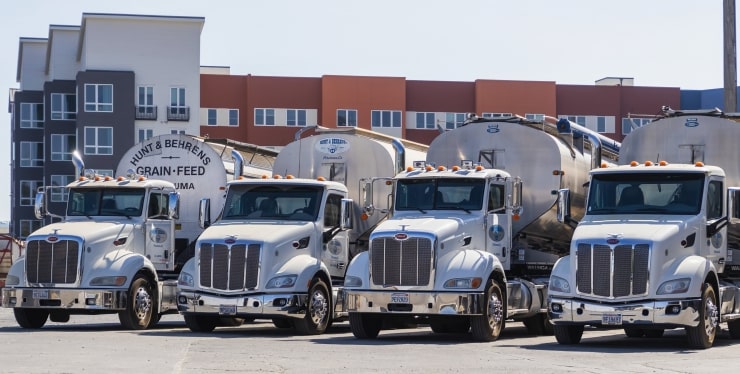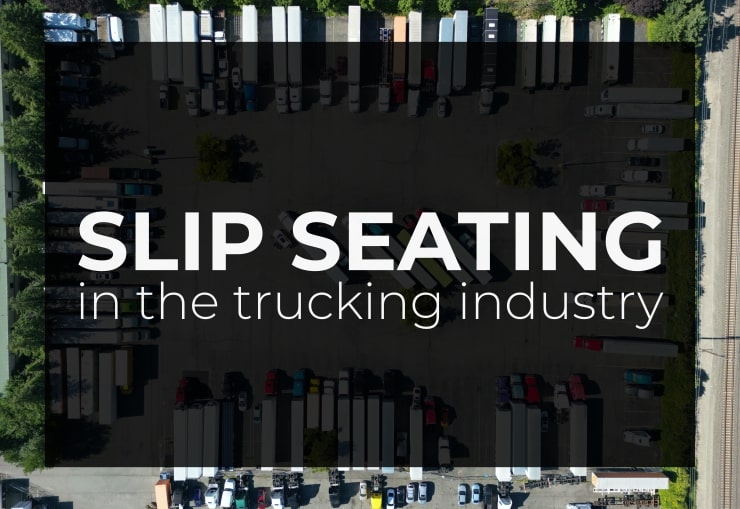If you’re a truck driver in the rapidly changing trucking industry, you’ll find slip seating to be a crucial practice, especially given the industry’s focus on efficiency and cost-effectiveness. This approach doesn’t just maximize fleet utilization; it also mirrors the dynamic nature of contemporary logistics and freight management.
What is slip seating in trucking?
Slip seating is a logistical approach wherein multiple truck drivers alternate the use of a single truck, rather than being assigned a permanent vehicle. This system allows for trucks to be in continuous operation, minimizing downtime and maximizing fleet efficiency. In essence, when one driver completes their shift, another takes over, ensuring the truck remains on the road for the maximum possible time.
Accordingly, a slip-seat driver is a truck driver who operates different trucks as needed, rather than having a single assigned vehicle. This approach differs from traditional trucking practices where a driver is typically assigned to and responsible for a single specific truck.
Historical context and evolution of slip seating practices
Historically, slip seating originated as a solution to maximize resource utilization in the face of growing demands for transportation and delivery services. Initially adopted in the mid-20th century, it was a response to the burgeoning trucking industry’s need to streamline operations and reduce costs.
Over the years, the implementation of slip seating has been shaped by various factors. In the early days, the practice was fairly rudimentary, often leading to issues like increased vehicle wear and driver dissatisfaction. However, as the trucking industry evolved, so did the approach to slip seating. The advent of advanced scheduling software in the late 1990s marked a significant turning point, allowing for more efficient and driver-friendly allocation of vehicles.
It is almost certain that slip seating can increase truck utilization given the fact that new trucks typically have a 700,000-mile warranty and need just a few hours of idle time for an oil change every 25,000 miles, allowing for 24/7 operation. The recommendation to operate trucks for 700,000 miles in three years underlines a significant potential for increasing operational efficiency through slip seating, which is not feasible with a single driver per truck. Companies employing slip seating generally have a reduction in operational costs due to better fleet management.
The practice has also been influenced by broader economic and societal trends. For instance, during economic downturns, such as the one experienced in 2008, slip seating became a crucial strategy for many companies to stay afloat, allowing them to maintain service levels with a reduced fleet. Conversely, during periods of economic growth, it has enabled companies to rapidly scale up their operations to meet increased demand.

In recent years, the focus has shifted towards addressing the challenges inherent in slip seating, such as driver health concerns and vehicle maintenance. The integration of IoT (Internet of Things) devices in trucks, for example, has allowed for real-time monitoring of vehicle conditions, reducing maintenance costs.
As the trucking industry continues to adapt to economic changes and technological advancements, slip seating remains a key component, evolving to meet the needs of both companies and drivers in the 21st century.
How does slip seating work?
Slip seating operates as a finely-tuned mechanism within the trucking industry, designed to enhance operational efficiency and resource utilization. This system hinges on strategic scheduling and coordination, ensuring that trucks are constantly in motion and effectively employed. The mechanics of slip seating involve a complex interplay of logistical planning, driver management, and vehicle maintenance.
Assignment Process
The assignment process in slip seating is a critical component, requiring meticulous planning and coordination. It begins with a centralized dispatch system, where dispatchers assign trucks to drivers based on several key factors. These include the drivers’ schedules, route requirements, and vehicle availability. Advanced scheduling software plays a crucial role in this process, enabling dispatchers to allocate trucks most efficiently. For example, a driver finishing a long-haul route in the morning can return a truck that will be reassigned to another driver for local delivery in the afternoon, thereby ensuring continuous vehicle use.
The assignment process also takes into account the specific needs of each trip, such as cargo type and delivery deadlines. This ensures that the right truck is allocated for the right job, optimizing both the vehicle’s capabilities and the driver’s expertise. In larger fleets, algorithms are used to analyze vast amounts of data, such as driver work hours, vehicle maintenance schedules, and route details, to make the most efficient assignments. These algorithms can increase fleet utilization by up to 25%, according to recent industry data.
Operational Procedures
The operational procedures in slip seating are designed to ensure smooth transitions between drivers and maintain vehicle integrity. This includes strict adherence to pre and post-trip inspections, which are crucial for identifying and addressing any maintenance issues. Drivers are required to complete detailed checklists that cover critical vehicle components like brakes, tires, and lights, ensuring the next driver receives a fully functional and safe truck.
Another key aspect of operational procedures is the management of driver-specific equipment and personal belongings. Given the shared nature of the trucks, drivers typically use portable storage solutions for their personal items, allowing for quick and efficient changeovers. Additionally, companies often implement standardized settings for onboard systems like seat adjustments and mirrors, reducing the time required for drivers to set up the truck according to their preferences.
These procedures are not just about efficiency but also about maintaining a high standard of safety and comfort for the drivers. For instance, some companies have adopted technologies like RFID (Radio-Frequency Identification) tags to streamline the handover process, where settings and preferences can be automatically adjusted to the incoming driver’s profile. This not only saves time but also enhances the driving experience, contributing to higher driver satisfaction rates.
Equipment and Technology Used
In slip seating, effective use of technology is key.
Fleet Management Systems (FMS) play a central role in managing fleet operations by tracking vehicles, scheduling maintenance, and managing drivers. This helps in efficient truck allocation, condition monitoring, and adherence to driving regulations.
Telematics, crucial for real-time tracking, uses telecommunications to transmit vehicle data. With GPS and IoT sensors, it provides immediate updates on vehicle location, fuel use, and driving patterns, aiding in route optimization and maintenance planning.
For vehicle inspections, digital tools are now standard. These tools, used via mobile apps or devices, facilitate efficient pre and post-trip checks and integrate with FMS for immediate maintenance notifications.
RFID technology is also emerging for driver identification, allowing for automatic adjustment of vehicle settings per driver, thus enhancing personalization and efficiency.
These technologies collectively enhance operational efficiency, safety, and compliance, crucial for slip seating’s success.
What is the role of dispatchers in slip seating?
In slip seating, dispatchers play a crucial role in managing fleet operations and ensuring optimal truck utilization while accommodating driver schedules. They need to understand driver qualifications, preferences, and regulatory constraints to align these with customer demands and efficient route planning. This role demands strong logistics skills and quick decision-making.
Dispatchers are responsible for assigning vehicles appropriately, and matching drivers to trucks based on variables like cargo, destination, and traffic. They must also handle unexpected scenarios, such as driver absences or breakdowns, to keep operations running smoothly.
Communication is another key aspect of a dispatcher’s role. They act as the main contact for drivers, providing essential information, resolving concerns, and supporting them during emergencies.
While fleet management software enhances dispatcher capabilities by offering real-time data on vehicle location and driver availability, the human element of experience and judgment remains indispensable for effective slip seating management.
Advantages and benefits of slip seating
Slip seating offers several advantages, primarily in terms of operational efficiency and resource optimization.
This system, while primarily designed to maximize the use of assets, also presents certain challenges that need to be carefully managed.
Cost-Effectiveness for Companies
Slip seating significantly enhances cost-effectiveness for trucking companies. By ensuring trucks are used more continuously, companies can reduce the total number of vehicles required in their fleet. This reduction leads to substantial savings in capital expenditures on new trucks, which can be a major portion of a company’s budget. For instance, data suggests that companies employing slip seating can reduce their fleet size by up to 20%, translating into direct savings in purchase and maintenance costs.
Operational costs also decrease as a result of better fuel efficiency and route optimization. By having trucks on the road more consistently, companies can plan routes more effectively, reducing empty miles and fuel wastage. A study showed that slip seating can lead to a 10-15% reduction in fuel costs, a significant saving given that fuel is one of the largest expenses in trucking operations.
However, there are drawbacks. The increased usage can lead to accelerated wear and tear on vehicles, necessitating more frequent maintenance. Additionally, not all drivers favor slip seating, as it can disrupt their sense of ownership and comfort with a particular vehicle, potentially impacting driver satisfaction and retention.
Maximizing Fleet Utilization with Slip Seating
Maximizing fleet utilization is another key advantage of slip seating. By rotating drivers across a fleet, trucks spend less time idle and more time on the road. This is especially beneficial for companies with high cargo demand, as it allows them to meet customer needs without investing in additional vehicles. Industry statistics indicate that slip seating can increase truck utilization rates by up to 30%, a significant boost in operational efficiency.

The system also offers flexibility in managing peak periods and varying cargo volumes. During times of high demand, slip seating enables companies to rapidly scale up their operations without the need for additional capital investment in more trucks. Conversely, during slower periods, it allows for more efficient use of the existing fleet, avoiding the costs associated with having surplus vehicles sitting unused. Despite its benefits, the challenge in maximizing fleet utilization lies in the complexity of scheduling and ensuring that drivers are adequately rested and compliant with hours-of-service (HOS) regulations. Effective use of fleet management software and careful planning are essential to harness the full potential of slip seating while maintaining a safe and compliant operation.
Flexibility in Operations and Scheduling with Slip Seating
Slip seating enhances operational flexibility, allowing trucking companies to quickly adapt to changing demands and driver availability. This system enables the easy reassignment of drivers to different routes or trucks, facilitating responsiveness to sudden shifts in cargo volume or delivery schedules. This adaptability is particularly valuable during peak seasons or unexpected demand surges, ensuring consistent service levels.
Additionally, slip seating can contribute to improved work-life balance for drivers by offering varied schedules and routes, which can help reduce burnout and enhance job satisfaction. Effective scheduling systems and clear communication are essential to balance this flexibility with safety and regulatory compliance.
However, many drivers are not accepting slip seating because of different reasons. Here is a table showing the benefits of slip seating for companies but also disadvantages for truck drivers.
| Advantages | Disadvantages |
| Increased Fleet Utilization: Vehicles are in use more consistently, reducing idle time. | Increased Vehicle Wear and Tear: More frequent use can accelerate the need for maintenance and repairs. |
| Cost-Effectiveness: Reduces the need for a larger fleet, saving on purchase and maintenance costs. | Driver Dissatisfaction: Some drivers may dislike not having a dedicated vehicle, affecting job satisfaction. |
| Operational Flexibility: Allows quick adjustment to changing demands and driver availability. | Complex Scheduling: Requires sophisticated scheduling systems and can be challenging to manage. |
| Reduced Fuel Costs: More efficient route planning and vehicle use can lower fuel expenses. | Hygiene Concerns: Shared vehicles can raise issues related to cleanliness and personalization. |
| Scalability during Peak Periods: Easier to handle increased demand without additional capital investment. | Training and Adaptation: Drivers and dispatchers may require additional training to adapt to the system. |
| Improved Service Levels: Ability to meet customer needs promptly and efficiently. |
How does Slip Seating impact on driver satisfaction and retention?
Slip seating’s impact on driver satisfaction and retention hinges primarily on vehicle maintenance and health concerns.
A key issue is driver dissatisfaction due to vehicle wear and tear, as multiple drivers use the same truck. This can lead to safety risks and maintenance problems, potentially increasing driver turnover. A majority of truck drivers prefer operating their own truck, underscoring the challenge of shared vehicle use.
Health risks, particularly in the context of pandemics, are also a concern. Shared confined spaces and inadequate cleaning time can expose drivers to health hazards, emphasizing the need for robust hygiene protocols.
It’s worth noting that driver retention trends vary, suggesting that while slip seating has challenges, it’s not the sole factor in driver turnover. Addressing vehicle maintenance, driver health, and job satisfaction is crucial for a stable workforce.
Regarding safety and security, key considerations include:
- Vehicle Maintenance
- Driver Familiarity with Vehicles
- Hygiene and Health
- Personal Safety
- Data Security
- Consistent Safety Practices
- Emergency Procedures
- Regulatory Compliance
These safety and security aspects are crucial for the effective implementation of slip seating, balancing operational benefits with the well-being of drivers and fleet security.
Best practices for Slip Seating
Implementing best practices in slip seating is crucial for maximizing its benefits while mitigating potential downsides. These practices ensure operational efficiency, driver satisfaction, and vehicle maintenance are optimally managed.
Here’s a table outlining some of the best practices for slip seating:
| Practice | Description |
| Regular Vehicle Maintenance | Implement a strict maintenance schedule to ensure vehicles are safe and reliable. |
| Comprehensive Driver Training | Train drivers on different vehicle models and company protocols to ensure they are prepared for any truck they might drive. |
| Effective Communication Channels | Establish clear and efficient communication systems between drivers and dispatchers for smooth operations. |
| Hygiene and Cleaning Protocols | Enforce rigorous cleaning protocols between shifts to maintain hygiene and health standards. |
| Use of Advanced Scheduling Software | Leverage technology to optimize truck and driver assignments and manage schedules effectively. |
| Personal Belongings Management | Provide solutions for the secure storage and transfer of personal belongings between drivers. |
| Safety and Compliance Monitoring | Regularly monitor and enforce safety standards and regulatory compliance to ensure safe operations. |
| Feedback Mechanisms | Implement systems to gather and address driver feedback, improving job satisfaction and retention. |
These practices help in creating a balanced and efficient environment for slip seating, which benefits both the drivers and the company.
The future of slip seating in trucking
The future of slip seating in the trucking industry is likely to be shaped by several key factors:
- Technological Advancements: As technology continues to evolve, slip seating operations will become more efficient and driver-friendly. Innovations in fleet management software, telematics, and automated scheduling systems are expected to streamline the slip seating process, making it easier to manage and more attractive to both drivers and companies.
- Driver-Centric Approaches: There’s a growing recognition of the importance of driver satisfaction and retention. The future of slip seating might see more emphasis on addressing the concerns of drivers, such as improved cab ergonomics, personalized settings, and better hygiene standards, to make the practice more appealing to them.
- Economic and Regulatory Influences: Changes in economic conditions and transportation regulations will continue to influence slip seating practices. For instance, environmental regulations might push for more efficient use of resources, further promoting the adoption of slip seating.
- Adaptation to Industry Challenges: Challenges like driver shortages and increasing operational costs might drive more companies to adopt slip seating as a way to maximize their resources.
Overall, the future of slip seating in trucking is poised for growth and evolution, with a strong focus on technology integration and driver welfare.
Wrapping-up
Slip seating in the trucking industry is a practice where multiple drivers share a single truck, rather than being assigned a permanent vehicle. This approach offers several benefits for trucking companies, including maximized truck utilization, cost-effectiveness, operational flexibility, and better tax incentives. By employing slip seating, companies can significantly enhance fleet utilization, allowing trucks to accumulate high mileage and reduce idle time, thereby optimizing revenue and minimizing expenses.
However, slip seating also presents certain challenges, particularly in terms of driver satisfaction and vehicle maintenance. Drivers may experience dissatisfaction due to the lack of a personal connection with a specific vehicle and concerns over hygiene in shared cabs. From a maintenance perspective, the increased wear and tear on vehicles necessitate stringent maintenance schedules.
The future of slip seating seems to be geared towards a greater emphasis on technology integration and driver welfare. Technological advancements like fleet management software and telematics are expected to make slip seating more efficient and appealing. At the same time, addressing drivers’ concerns will be crucial for the successful implementation of this practice.
While slip seating offers numerous advantages for trucking companies, balancing these with the challenges of driver satisfaction and vehicle maintenance will be key to its continued adoption and success in the industry.

